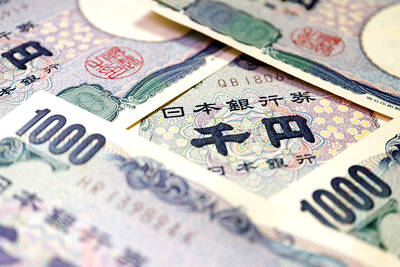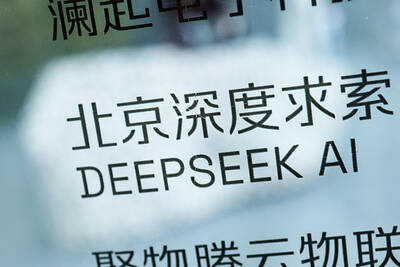China’s trade surplus narrowed last year for the second straight year, giving Beijing grounds to rebuff US pressure for faster currency appreciation ahead of Chinese President Hu Jintao’s (胡錦濤) visit to Washington next week.
The Chinese government will point to the latest numbers as evidence that it is making steady progress in rebalancing its economy toward domestic consumption, cutting reliance on exports and giving the world a lift through surging demand for imports.
For the US, however, this may be happening too slowly, with the politically sensitive bilateral trade gap between the world’s two biggest economies widening further last year.
However, last month was consistent with what has been a pattern since the outbreak of the global financial crisis more than two years ago. With the Chinese economy growing much faster than the rest of the world, imports outshone exports.
China’s exports last month rose 17.9 percent from a year earlier and imports increased by 25.6 percent, the customs agency said yesterday.
That left the country with a trade surplus of US$13.1 billion, well down from analysts’ expectations of a US$20 billion figure and the lowest in eight months.
“Imports are much stronger than we have expected, indicating that the domestic investment and internal demand are mainly pushing up domestic consumption,” said Wang Han, an economist at advisory firm CEBM in Shanghai.
For all of last year, China’s trade surplus was US$183.1 billion, down 7 percent from US$196.1 billion in 2009. The surplus had fallen 34 percent in 2009 from its pre-crisis peak of nearly US$300 billion in 2008.
“This could reduce the pressure for yuan appreciation and also remove some pressure for the central bank to imminently launch aggressive tightening,” said Wang Hu, an economist with Guotai Junan Securities.
Along with quickening the pace of yuan gains, the government raised interest rates twice and banks’ required reserves six times last year to rein in inflation.
A smaller trade surplus means that less money is flowing into China, decreasing the central bank’s urgency to mop up the excess cash in the economy that has pushed prices higher.
Beijing has let the yuan rise 3 percent against the US dollar since mid-June, when it lifted the currency from a nearly two-year peg that cushioned the economy from the impact of the global financial crisis.
Critics in the US say that China keeps the yuan cheap to give its exporters an unfair advantage in selling their wares to the world.
These long-standing complaints have taken on added potency in the wake of the financial turmoil that has left the US with an unemployment rate of 9.4 percent.
However, Beijing has counseled for patience, repeatedly pledging to reduce its economy’s reliance on exports and to seek a more balanced trade relationship with the rest of the world.
It has begun to move in that direction on the back of surging imports of oil, iron ore, copper and other raw materials needed to fuel its economy.
However, apart from agricultural goods such as soy beans, the US provides few of the commodities sought by China. That mismatch showed in another huge trade gap between the two last year: US$181.3 billion, up 26 percent from 2009, according to the Chinese data.
Trade is just one thorn in the side of China-US relations. The two countries also locked horns last year over deadly North Korean attacks on South Korea, Internet censorship, human rights, South China Sea navigation, climate change and valuable rare-earth minerals.
Hu Jintao will meet US -President Barack Obama in Washington on Jan. 19, an event that is being billed as the most important state visit in 30 years.
There are signs that China’s overall trade surplus, having narrowed in 2009 and last year, could rebound this year.
The export order sub-index in the country’s purchasing managers’ index, a leading indicator of export demand, has been very strong of late, Goldman Sachs economists Yu Song (宋玉) and Helen Qiao (喬虹) noted.
Liu Li-gang (劉利剛), an economist with ANZ in Hong Kong, said that improvements in the US jobs market would also shore up global demand.
“We still see a robust year ahead for China exports,” he said.

AI TALENT: No financial details were released about the deal, in which top Groq executives, including its CEO, would join Nvidia to help advance the technology Nvidia Corp has agreed to a licensing deal with artificial intelligence (AI) start-up Groq, furthering its investments in companies connected to the AI boom and gaining the right to add a new type of technology to its products. The world’s largest publicly traded company has paid for the right to use Groq’s technology and is to integrate its chip design into future products. Some of the start-up’s executives are leaving to join Nvidia to help with that effort, the companies said. Groq would continue as an independent company with a new chief executive, it said on Wednesday in a post on its Web

RESPONSE: The Japanese Ministry of Finance might have to intervene in the currency markets should the yen keep weakening toward the 160 level against the US dollar Japan’s chief currency official yesterday sent a warning on recent foreign exchange moves, after the yen weakened against the US dollar following Friday last week’s Bank of Japan (BOJ) decision. “We’re seeing one-directional, sudden moves especially after last week’s monetary policy meeting, so I’m deeply concerned,” Japanese Vice Finance Minister for International Affairs Atsushi Mimura told reporters. “We’d like to take appropriate responses against excessive moves.” The central bank on Friday raised its benchmark interest rate to the highest in 30 years, but Bank of Japan Governor Kazuo Ueda chose to keep his options open rather than bolster the yen,

Even as the US is embarked on a bitter rivalry with China over the deployment of artificial intelligence (AI), Chinese technology is quietly making inroads into the US market. Despite considerable geopolitical tensions, Chinese open-source AI models are winning over a growing number of programmers and companies in the US. These are different from the closed generative AI models that have become household names — ChatGPT-maker OpenAI or Google’s Gemini — whose inner workings are fiercely protected. In contrast, “open” models offered by many Chinese rivals, from Alibaba (阿里巴巴) to DeepSeek (深度求索), allow programmers to customize parts of the software to suit their

Global server shipments are expected to surge to 15 million units next year, from 4 million units this year, with artificial intelligence (AI) servers accounting for about 30 percent, driven by massive capital spending by major cloud service providers, the Market Intelligence and Consulting Institute (MIC) said on Thursday last week. Major cloud service providers — including Google’s parent company Alphabet Inc, Microsoft Corp, Amazon.com Inc and Meta Platforms Inc — are projected to budget US$450 million for capital expenditure next year, up from US$400 million this year, MIC ICT [information and communications technology] Industry Research Center director Edward Lin